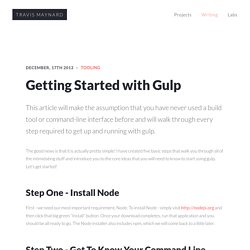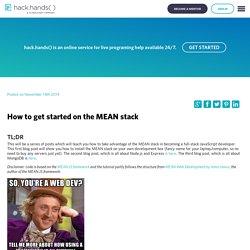

Getting Started with Gulp. December, 17th 2013 · tooling This article will make the assumption that you have never used a build tool or command-line interface before and will walk through every step required to get up and running with gulp.

The good news is that it is actually pretty simple! I have created five basic steps that walk you through all of the intimidating stuff and introduce you to the core ideas that you will need to know to start using gulp. Let's get started! Web%20Applications%20Development%20Workflow%20-%20EclipseCon%20France.pdf. Getting Started with gulp.js. Gulp.js is a fantastic way of removing some of the more mundane parts of a web designer or developer’s job.

It takes away all the tasks you should be doing and probably some of the ones that you’re not but should be! For example tasks like: compiling your CSS, LESS or SASS down to minified versions with vendor specific prefixesminifying, obfuscating and even uglifying your CoffeeScript or JavaScript files down to production versionspush to your browser so you can see the changes without reloading the pageautomatically run PHPUnit (for example) against any code changesand watch for anything above changing and do it all again! Gulp.js is a JavaScript based command line task runner built using Node.js. Now if you are using something like Grunt the above will make absolute sense. First things first, you’ll need Node.js installed, which is beyond the scope of this introduction but is particularly easy, especially if you’re on a Mac like myself. Create a test folder somewhere on your machine. Book of Modern frontend tooling. Tooling/book-of-modern-frontend-tooling. Maxogden/art-of-node.
@inadarei: Most Important Node.js Modules. Free developer webcasts at DevelopMentor. The Definitive Guide to Object-Oriented JavaScript. Creating a Simple MEAN Web Application (MongoDB, Express, AngularJS, NodeJS) Build A Killer Node.js Client for Your REST+JSON API. Making a Pokemon App w/ the MEAN Stack. MEAN Stack Intro: Build an end-to-end application. How to get started on the MEAN stack. This will be a series of posts which will teach you how to take advantage of the MEAN stack in becoming a full-stack JavaScript developer.

This first blog post will show you how to install the MEAN stack on your own development box (fancy name for your laptop/computer, so no need to buy any servers just yet). The second blog post, which is all about Node.js and Express is here. The third blog post, which is all about MongoDB is here. Disclaimer: code is based on the MEAN.JS framework and the tutorial partly follows the structure from MEAN Web Development by Amos Haviv , the author of the MEAN.JS framework. Linux server on which you're running anApache web server withMySql as a database andPHP as the backend language Of course, if you're developing for the web, a knowledge of HTML and CSS is a must. One language to rule them all. MEAN.JS - Full-Stack JavaScript Using MongoDB, Express, AngularJS, and Node.js. Full-Stack JavaScript With MEAN And Yeoman.
Introduction A trend proliferating amongst prototypers in the Angular community is full-stack JavaScript development via the MEAN stack.

The acronym stands for: (M)ongoDB – a noSQL document datastore which uses JSON-style documents to represent data, (E)xpress – a HTTP server framework on top of Node, (A)ngular – as you know, the JS framework offering declarative, two-way databinding for webapps and (N)ode – the platform built on V8’s runtime for easily building fast, scalable network applications. Supporters of the stack claim the use of JavaScript all the way down increases productivity and it’s hard to dispute that this notion is pretty appealing. You get consistent models across the stack and consistent best practices in many cases too. For example, in the case of Mongo – you can store documents in a JSON-like format (BSON – Binary JSON objects), author JSON queries in Express/Node and pass these JSON documents back to an Angular powered frontend. Why MongoDB? Why Express? Features: Yeoman with Addy Osmani. YEOMAN TUTORIAL - Master Front-End Workflow with Yeoman, Grunt and Bower.